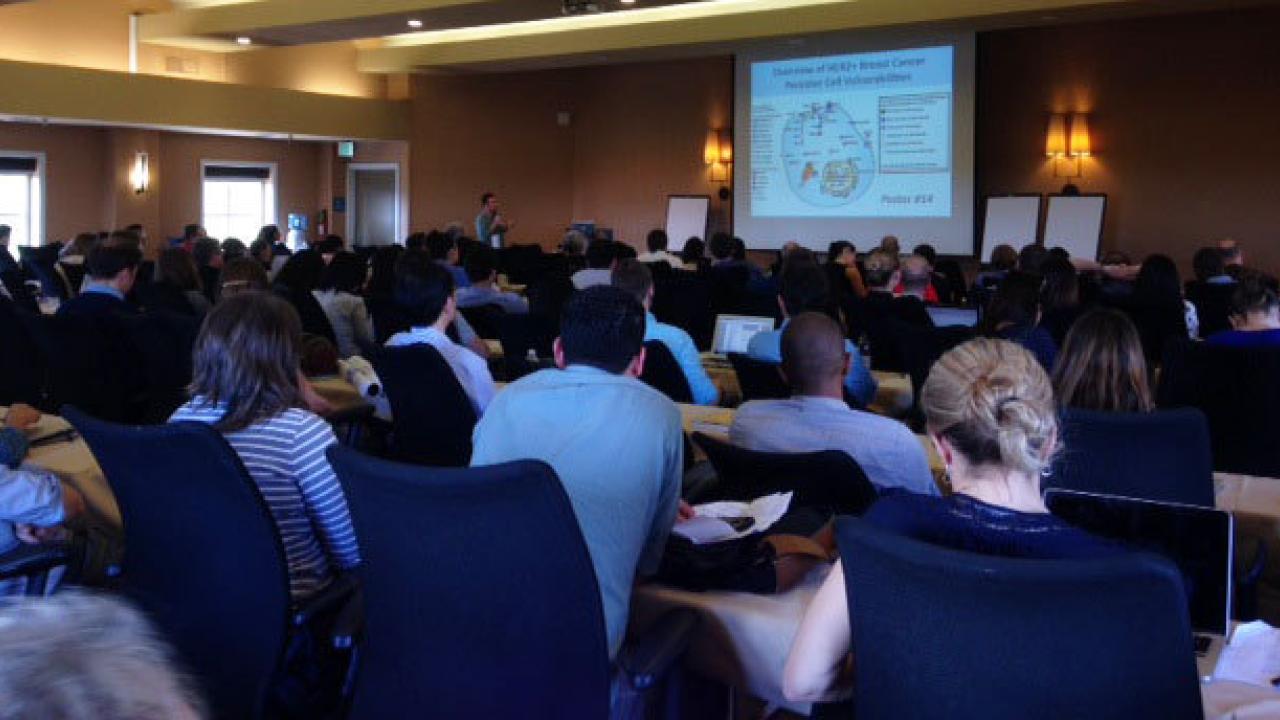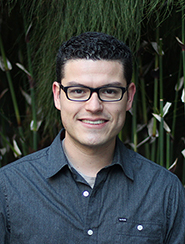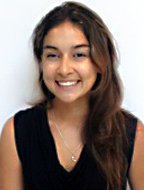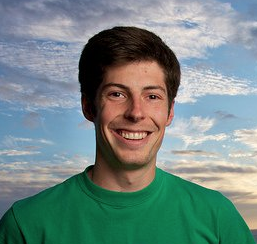
Clinicians, bench scientists and translational researchers - medical oncologists and radiation oncologists, immunologists, chemists and geneticists discusses strategies for collaboration at the Helen Diller Family Comprehensive Cancer Center Off-site Scientific Retreat, March 13-14, 2015 in Santa Cruz.
In concept, it’s simple: Figure out how the cancer works, develop treatments that target the problem areas and cure the disease.
In practice, of course, those working in the field know there is nothing simple about this lethal, at times heartbreaking contest of whack-a-mole.
Tracking types, sub-types, genetic mutations, signaling pathways, transcription and translation factors, macrophages, lymphocytes, stromal cells, the tumor microenvironment and on has proven to be enormously difficult and elusive science. The suffering of patients through one hope-infused trial after another exacts an enormous emotional toll.
 These factors combine to continuously ramp up pressure to find the cures. Perhaps this is why some in the cancer community have come to
These factors combine to continuously ramp up pressure to find the cures. Perhaps this is why some in the cancer community have come to
believe that the best hope for speeding what has already been a multi-generational effort lies in creating a parallel to the diseases themselves – a way to ingeniously blend great minds, scientific tools, clinical samples and patient concerns so as to create a rapidly proliferating knowledge base that is precisely targeted to patient needs.
Such is the thinking behind retreats like the Helen Diller Family Comprehensive Cancer Center retreat that took place in Santa Cruz, the weekend of March 13-14, 2015. Brilliant junior researchers interacted with their more experienced colleagues from different labs who work in different disciplines. Clinicians, bench scientists and translational researchers – medical oncologists and radiation oncologists, immunologists, chemists and geneticists – formally and informally tested each other’s assumptions, offered suggestions, honed and shaped and found places where their work might combine to accelerate discovery.
"This is a circular process, not something linear that goes back and forth from bedside to bench and back again. We need to come at it from different angles, from a community of ideas where we can have some exciting cross-fertilization. Otherwise, we might miss some important discoveries."
Pamela Munster
According to Director of the Preclinical Therapeutics Core Facility Rosemary Akhurst, PhD and Director of the Early Phase Clinical Trials Unit Pamela Munster, MD, who co-organized the effort, the goal was to foster and nurture a culture in which open-ended collaboration is truly synergistic.
“We’re trying to create a family because drug development has to be a multi-faceted approach,” said Munster. “The retreat reflects [new Cancer Center Director Alan Ashworth’s] focus on driving our work from patient needs. Young, creative minds are critical and so is remembering this is a circular process, not something linear that goes back and forth from bedside to bench and back again. We need to come at it from different angles, from a community of ideas where we can have some exciting cross-fertilization. Otherwise, we might miss some important discoveries.”
According to many of the junior researchers who presented at the conference, some version of that culture already exists at UCSF.
Postdoctoral scholar Ana Ruiz-Saenz presented a study that described a novel strategy to selectively attack HER3 TK receptor, which has a key role in several types of human cancers and, in particular, in HER2-amplified cancers. This strategy involves a new compound – CT8 – that eliminates HER3 expression and function by blocking its translocation into the endoplasmic reticulum; the combination of CT8 with lapatinib increased cell death from 20% to 50% in HER2-amplified breast cancer cells. The work appeared recently in Oncogene. “UCSF and the Cancer Center is the best place to do my work, because I have the opportunity to work with exceptional researchers such as Dr. Jack Taunton who provided us with this new compound and my mentor [hematologist-oncologist Mark Moasser, MD] who is world-renowned for his work on HER2-amplified cancers” said Ruiz-Saenz. “This really speeds up the work and improves its quality. We completed a study in one year that might have taken three to five somewhere else.”
Others spoke of access to extraordinary tools (“we can even do MRIs on mice!”), “the best immunology labs in the world,” the NIH funding, access to cancer genes, and an extraordinarily welcoming spirit of collaboration.
 This year’s retreat was focused on building on those strengths – in a sense, supercharging them, much as some of the recent cancer immunotherapies attempt to supercharge the body’s immune system to fight the disease.
This year’s retreat was focused on building on those strengths – in a sense, supercharging them, much as some of the recent cancer immunotherapies attempt to supercharge the body’s immune system to fight the disease.
On Friday night, at a table with people swirling around them, Ashworth huddled in intense conversation with John Gordan, a junior researcher. Saturday afternoon, during the poster session, Munster listened intently to postdoctoral scholar Swati Kaushik, PhD explain her work. At lunch on Saturday, faculty members Akhurst, Adil Daud, MD, Catherine Park, MD and Alan Balmain, PhD shared a table until Akhurst left to confer with doctoral student Tali Mazor.
During the large group presentations, Munster described for the junior researchers how to shape their work to make it more appropriate for early phase trials. Immunologist Lewis Lanier, PhD, marveled at the progress in immunotherapy and then described some important recent work.
 It’s impossible to know the many directions such interactions might go but the hope is that they – and the remarkable work that stimulated them – offer a new and more potent approach to battling cancer.
It’s impossible to know the many directions such interactions might go but the hope is that they – and the remarkable work that stimulated them – offer a new and more potent approach to battling cancer.
Over the next weeks and months, we will roll out brief descriptions of the junior researchers’ work to give our entire cancer community a sense of the work that is in progress here and of the quality of the people doing that work. To begin that process, here are the award winning posters and talks from the retreat.
The Prize Winners





Adrian Contreras
Best Graduate Student Poster
"Single nucleotide modifications on the ribosome promote the translation of p53 and its activity in tumor suppression."
While much of the cancer field has been focused on studying genes that encode proteins, PhD student Adrian Contreras of the Ruggero Lab is investigating what is sometimes termed the dark matter of the genome: noncoding RNAs – snoRNAs, in particular – that modify ribosomes, the molecular complex that makes proteins, and which is frequently altered in cancer. Until now, however, it’s been unclear, if snoRNAs play a role in tumorigenesis.
Contreras conducted a study in which he inhibited two modifications guided by a single snoRNA on the ribosome and found that doing so stopped the production of specific proteins that are key tumor suppressors. These findings represent a breakthrough in our understanding of how the function of the ribosome is regulated by these modifications. Contreras now speculates that it may be possible that prostate, blood and breast cancer patients who have lower levels of the modifications may not make sufficient amounts of tumor suppressor proteins to fight their cancers.
The next step is to use the targets discovered from these findings as biomarkers that indicate the modification status in ribosomes of patients and correlate that with how well tumor suppressors are being made. One possibility is to measure these ribosome modifications in biopsies or in blood of cancer patients to assess if these novel biomarkers can be insightful in terms of disease progression or severity – and if so, suggest possible therapeutic directions.
“At the retreat, I was able to interact with people in the cancer field at UCSF – learn about what they are doing and make connections for research collaborations,” said Contreras. “I actually met several people from other labs doing research that is very exciting for my project.”

Robert Bell
Best Graduate Student Talk
"GABP selectively binds and activates the mutant TERT promoter across multiple cancer types"
Reactivating expression of the TERT gene is a common mechanism cancer cells use to become “immortal.” In 2013, researchers discovered that hotspot activating mutations in the TERT promoter commonly occur across multiple cancer types, including 83% of glioblastomas, the most aggressive form of adult brain cancer. This motivated graduate student Robert Bell of the Costello and Song laboratories to focus on figuring out exactly how the mutations lead to increased TERT reactivation. His group’s hypothesis was that the mutation allowed a specific DNA-binding protein, called a transcription factor, to bind to the TERT promoter and reactivate the gene, but no one had identified the transcription factor.
Working at first with a patient-derived glioblastoma culture, Bell and his colleagues narrowed their search to four transcription factor candidates and ultimately discovered GABPA as the single transcription factor to selectively regulate the mutant TERT promoter. The team then extended testing to cell lines representing four different cancer types, ultimately finding that GABPA bound to the TERT promoter in all mutant cell lines tested, but could not recognize the un-mutated promoter. Bell’s findings implicate GABPA as a critical transcription factor in melanoma, glioblastoma, liver cancer, and neuroblastoma – all cancers known to harbor TERT promoter mutations. If that theory holds, GABPA could become a precision therapeutic target for cancers that have this mutation. The work appears in Science, on the Science Express web site. Bell and his lab colleagues are now conducting a variety of experiments designed to test whether inhibiting GABPA activity not only turns down TERT expression, but also results in selective cancer cell death.
“Our tight link to the hospital enabled us to quickly get human tumor samples from which we could grow cultures and produce relevant models,” said Bell. “That collaboration between the clinic and the lab ensures lab research is directed toward benefiting patients. [And] being part of the Cancer Center allowed us to obtain cell lines of multiple different cancer types and quickly expand our initial finding beyond glioblastoma. That was enormously important.”

Tsun-Wen (Sheena) Yao
Best Postdoctoral Poster
"Feedback Activation of EGFR via PTPN9 leads to Glioma Escape from BRAFV600E Targeted Therapy"
Postdoctoral scholar Tsun-Wen (Sheena) Yao of the Nicolaides lab is interested in understanding why approved drugs for melanoma that inhibit the genetic mutation BRAFV600E work poorly in brain tumors despite the mutation having been found to be a common cause of pediatric glioma. Yao and her colleagues treated brain tumor cells in vitro with the approved BRAFV600E inhibitor and saw a significant reduction in the enzyme PTPN9, which leads to activation of EGFR signaling and increased tumor growth.
With that information in hand, the lab implanted brain tumor cells in animal models and treated them with a combination of BRAFV600E and EGFR inhibitors. The combination treatment resulted in significant regression of the tumors and considerable cancer cell death, with the tumor almost completely disappearing in some cases and the animals having much improved survival rates compared to those treated with single drugs or the control group. The results, said Yao, indicate that the combination therapy is a very promising therapeutic strategy for glioma patients carrying the BRAF V600E mutation. Having recently co-authored a paper in Molecular Cancer Therapeutics that described a novel EGFR inhibitor, NT-113 – one that effectively crossed the blood brain barrier in animal models – Yao and her colleagues are currently testing this novel EGFR inhibitor in combination with BRAFV600E inhibitor in animal models.
“I really love the resources we have here,” said Yao. “This type of brain tumor model is not easy to generate, but we have very good platforms here. We also have very good collaboration with MDs. Talking with them gives me much better perspective on my work, relevant to the clinical applications – I love the tight connection between basic science, translational science and clinical science.”

Crystal Conn
Best Postdoctoral Talk
"eIF4E is rate-limiting for the oncogenic cellular stress program but not normal mammalian development and global protein synthesis"
Working with colleagues in the Ruggero lab and the Barna lab at Stanford University, postdoctoral fellow Crystal Conn participated in a series of studies that are redefining our understanding of the role that the major cap binding protein eIF4E plays in development, cancer, and global protein synthesis. Two of the key findings: eIF4E is not rate limiting for global protein synthesis and mammalian cells have evolved excess levels of eIF4E that cancer cells hijack to drive the translational program that supports tumor survival.
The findings emerged when Conn and colleagues generated the first genetic loss-of-function mouse model for eIF4E and discovered that eIF4E exists in surplus for normal mammalian development. Using genome-wide translational profiling of mRNAs, they found that eIF4E dosage is critical for translating key homeostatic networks during oncogenic transformation. In particular, Conn showed that eIF4E dose is essential for translating a subset of antioxidant genes that regulate reactive oxygen species (ROS), a hallmark of oncogene-induced stress. This regulation occurs, at least in part, through a novel regulatory sequence that sensitizes these mRNAs to eIF4E dosage. The researchers further saw that a reduction of eIF4E levels deregulated the intra-tumoral oxidative stress response required for lung tumorigenesis in vivo, thereby decreasing tumor burden and progression.
“Since reducing eIF4E dose has no impact on normal cellular function, a logical next step is to create a therapeutic regimen that decreases eIF4E expression in cells,” said Conn. “Further understanding of the mechanisms underlying eIF4E dependent translation will allow for the identification of new molecular targets, and ultimately drug discovery. At UCSF, research like this is expedited due to access to state of the art facilities, scientific collaborations, and patient samples that altogether serve to advance translational medicine.”